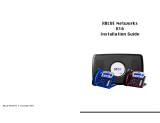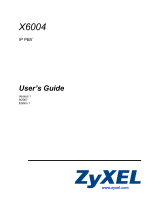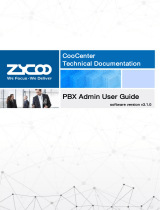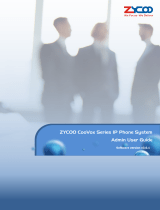
XBLUE QB
Setup Guide
20180406001
QB1
QB2

20181127001 XBLUE QB Setup Guide
2/19
Contents
About This Guide ........................................................................................................................................................... 3
Defaults (what is set at the factory): ................................................................................................................. 3
Before You Start ............................................................................................................................................................ 4
Package Contents ............................................................................................................................................ 4
Online aids ........................................................................................................................................................ 4
Hardware Overview .......................................................................................................................................... 5
LED Indicators – Resource and Port Description/Status .................................................................................. 6
Installation .................................................................................................................................................................... 7
Safety Precaution and Installation Warnings .................................................................................................... 7
Module Installation ............................................................................................................................................ 7
Desktop Installation – QB1 ............................................................................................................................... 8
Connecting the Equipment ............................................................................................................................................ 8
Configuration of QB/Get Phones Working ..................................................................................................................... 9
To find the IP Address of the QB1 .................................................................................................................... 9
Access the QB server programming interface ................................................................................................ 11
Getting your XBLUE IP Phones working ........................................................................................................ 12
Ensure Dedicated spot for QB on your network .......................................................................................................... 14
Secure the QB Server IP Address on your network ....................................................................................... 14
Revision History
Revision
Date Released
Changes
20180406001
May 28, 2018
Initial release
20180529002
May 29, 2018
Spelling and various corrections
20180601003
June 1, 2018
Format changes. Included IVR/AA setup section
20181127001
Nov 27, 2018
Added changed Admin Password (FW 30.10.0.17+ requires stronger password)

20181127001 XBLUE QB Setup Guide
3/19
About This Guide
Thank you for choosing a XBLUE QB PBX (Quad-Band PBX) server. XBLUE QB Series PBX
servers are a stand-alone telephone system providing the user with an on-premise, fully-featured
business telephone system. Your XBLUE QB PBX is an advanced application telephone system in
an IP server format connected using your local area network. QB Series PBX’s are hybrids capable
of PSTN (Regular Phone Lines), VoIP Phone Lines, GSM Telephone Lines, or LTE Telephone
Lines/Data Circuit (for voice communications). The configuration of your server depends upon the
Package you’ve purchased. This guide is intended to get your telephone system functioning in the
quickly.
XBLUE pioneered the self-install business telephone system in 2007 and continues to deliver easy
to install and administer business phone systems in a DIY fashion to save you money. However, if
you need help, we are available to assist you. Call us for a conversation with a live, technically-
capable person if needed at 866-925-8312. This guide will cover connection and access of the
server and XBLUE IP Phones and connection of analog telephone lines.
Your QB PBX is an advanced application product that is best adapted into your network by
preparing for the installation. First gather information about your office network to prepare to
connect your QB PBX into that environment.
Synopsis of what follows to get your telephone system functional:
1. Find your network IP Address scheme (Subnet)…
a. A LAN (Local Area Network) is a Private network that cannot be navigated via the
internet. Private IP Address segments begin with 192.168.x.x, or 172.16-31.x.x, or
10.x.x.x
2. Find the IP Address of your router.
3. Connect LAN port of the QB server to the existing network.
4. Connect all XBLUE IP7g telephones to the existing network.
5. Using an internet browser (Chrome, Firefox, Microsoft Edge, Safari) visit the Advanced IP
Scanner website and use that utility to discover the IP Address that your network has
assigned to the QB server.
6. Set that IP as RESERVED in your network router. [If you use an ISP router (Comcast, Time
Warner, Frontier, etc.) you can contact them for help with this step.]
7. Using your browser, log into the QB server using the IP Address discovered.
8. Run QB Server Auto Provisioning application to set the extension numbers of each of the
phones connected.
After completing these steps, the QB server and IP7g telephones will be functional for the
operations most often required in business communications. There are many ways to customize
your caller experiences and many features available. Enjoy your QB server, IP7g telephones and all
that is possible using the guides that we have loaded on our website. Visit often as we post frequent
updates.
Defaults (what is set at the factory):
• Extension range is set 101 – 599.
• All extensions have an associated voicemail box with a password that is the extension
number.
• Extensions assigned are 101 – 199 depending on the server.
• All telephone lines are set to ring into Queue 6700.
• When no one answers an incoming call, after 25 seconds that caller is routed to the IVR
(Auto Attendant) where they hear the default greeting for the Day answering mode.
• All outward calling is limited to numbers beginning with a 2-9 or numbers that begin with a
“1” but no longer than 11-digits.
• Paging Group 6300 is set for the first 25 extensions.

20181127001 XBLUE QB Setup Guide
4/19
• Voice CODEC usage is set for G.711u as the first choice and G.722 as the second choice
Related Documents
This Setup Guide explains the installation of XBLUE QB PBX telephony Server and getting XBLUE
telephones working. The documents below should also be referenced and will aid in specific
programming and user information:
Document
Description
XBLUE QB Series Datasheet
Datasheet for the XBLUE QB Series IP PBX.
XBLUE QB Series Administrator Guide
Refer to this manual for instructions on how to configure,
operate, monitor, and maintain the XBLUE QBPBX.
XBLUE IPT7g User Guide
This guide is a guide to the operations of the IP7g
specifically as it relates to any server environment.
XBLUE QB Extension Users Guide
The Extension Users Guide is a guide to the use of the
extension as it relates to the QB server. Including the
instructions on how to log into the user portal, configure
the account, listen to call recordings, check voicemail
messages, and other extension related operations.
Before You Start
Before you begin to install your QB PBX server, please check the package contents to verify that
you have received the items below. If there are any discrepancies please contact us so that we can
make it right. 866-925-8312
Package Contents
(1) QB PBX*
(1) Power Adapter*
(1) Network Cable
(2) Telephony Line
(4) Rubber Feet*
(1) Warranty Card
(1) Quick Installation Guide
* Note that the PBX model will vary depending on the package purchased. Note also that “Rubber
Feet” and “Power Adapter” apply only the QB1 PBX server. QB2,3 & 4 PBX servers include
mounting hardware and power cord.
Online aids
We are continually developing online aids for installation assistance.
Please check our website for updates on a regular basis.
xblue.com/customer-support-service/qb-support/
You can use your smart phone to scan this URL with a QR Scanner.
Permanent

20181127001 XBLUE QB Setup Guide
5/19
Preminate
Hardware Overview
Front Panel – QB1
Rear Panel – QB1
Front Panel – QB2
Rear Panel – QB2

20181127001 XBLUE QB Setup Guide
6/19
LED Indicators – Resource and Port Description/Status
LED
Status
Status
Description
POWER
Power status
On - Green
Power ON
Off
Power OFF
System
System status
Blinking – Green
The system is running properly
Steady/Off
The system is not running properly
WAN
WAN status
Steady – Green
Network Link is active
Blinking – Green
Data Traffic detected (normal)
Off
Off-line
LAN
LAN status
Steady – Green
Linked normally
Blinking – Green
Data Traffic detected (normal)
Off
Off-line
Analog Port
Status
Analog
Extension (FXS)
Green Steady
Green Blinking
• The port is idle
• There is an ongoing call on the port
Analog Line
(FXO)
Red Steady
Red Slow Flash
Red Fast Flash
• PSTN Line is idle
• No PSTN line is connected to the port
• The PSTN line is busy
Cellular
GSM/CDMA/3G
Red Steady
Red Slow Flash
Red Fast Flash
• Line is idle
• No SIM card detected
• Line is in use

20181127001 XBLUE QB Setup Guide
7/19
Installation
Safety Precaution and Installation Warnings
To avoid personal injury or damage to the device:
Power
• Use only the power adapter/cord provided with the QB PBX.
• Keep the power OFF during installation and while installing/changing modules.
• Do not open or remove the cover of QB PBX when it is in operation.
• Remove the cover ONLY when power is disconnected.
• Before cleaning the device, turn OFF the power supply.
o To clean; use a damp (NOT WET) soft cloth as routine maintenance.
o Avoid contact with the port connectors. If port connections become wet allow them to
dry COMPLETELY before restoring power.
Environment
• This device is intended for inside use only.
• Install the XBLUE QB PBX in a location that is clean, free from vibration, electric shock,
static electricity and temperature/humidity extremes.
o The operating temperature should be kept below 80°F (27°C).
o The humidity should be less than 95% and NON-Condensing.
• Do NOT install in a moist or wet environment.
• Install in a location where the device is easily accessed for periodic maintenance.
Module Installation
XBLUE QB servers support various port configuration modules listed below. The optional modules
are installed in Module Slots inside each server. QB3 & 4 require a module adapter (QBXP8) to
install any optional module.
Modules
Server
Quantity of Modules possible
• QBS2 Port Module
• QBO2 Port Module
• QBSO Port Module
• QBGSM Port Module
• QBLTE Module
• QBXP8 (QB3&4 only)
QB1
QB2
QB3
2 Slots, 2 Module Max
4 Slots, 4 Modules Max
8 Slots possible, 8 Modules
Max. Note: QB3&4 require
Module mounting boards
QBXP8 which allow 4 slots
each when installed.
Notes
• If the bundle you’ve ordered includes a XBSO Module (one
line and one analog phone port) it will be installed in the
first position and PORT1 of you server will be the ANALOG
PHONE PORT.
• Line PORTS begin at PORT1 or 2 if the XBSO is installed.
• If port configuration is to be changed, pre-installed modules
must first be removed.

20181127001 XBLUE QB Setup Guide
8/19
Desktop Installation – QB1
WARNING
• Ensure that a space of 5~10cm (2-4 inches) is maintained around the
QB device for air circulation.
• Do NOT stack anything on top of the QB device.
• The QB2 and QB3 should be wall or rack mounted.
QB1 is a desk-mounted device and shipped with rubber feet to keep it stable on the desktop. The
rubber feet cover the device’s assembly screws when installed. These screws are accessible when
shipped to allow Module configuration changes if desired.
• STEP 1 Place the QB1 server
upside-down on a stable surface.
• STEP 2 Remove the adhesive
backing paper from the rubber feet
provided.
• STEP 3 Attach the rubber feet to the
recessed areas on the bottom at
each corner of the device.
Connecting the Equipment
STEP 1 Connect one end of a network cable (provided) to the LAN port of XBLUE QB1, and the
other end to any LAN port of your company’s LAN data-switch or router. It must be
connected to the same network to which the XBLUE IP Phones are connected.
STEP 2 Connect the telephone lines from your service provider interface to the ports of the QB
(QB1: 1~4)(QB2: 1~8). Note: VoIP Lines have no cable/wire connections, they are
programmed into the server.
Modules
Installed
Chassis
Port
Description
QBSO and
QBO2
1
2
3
4
Connect phone cable to Analog Phone/Speakerphone/Cordless
Connect phone cable to Telephone Line (Provider)
Connect phone cable to Telephone Line (Provider)
Connect phone cable to Telephone Line (Provider)
QBO2 (2x)
1
2
3
4
Connect phone cable to Telephone Line (Provider)
Connect phone cable to Telephone Line (Provider)
Connect phone cable to Telephone Line (Provider)
Connect phone cable to Telephone Line (Provider)
STEP 3 Plug the provided power adapter into the power jack on QB1 and the other end to a
standard electrical wall socket. Wait for the system to boot up which is indicated by blinking
SYSTEM LED.

20181127001 XBLUE QB Setup Guide
9/19
Configuration of QB/Get Phones Working
XBLUE QB IP Telephony Servers are administered using a web browser. When the QB is
connected to your network it will obtain an IP Address from your network. To begin you must find
that IP Address given to the server by your network. You may also use your router to discover the IP
Address of the XBLUE QB Server. This is done using your router’s Connected Device function
however since there are many variations of routers we will use the network scanner approach in this
guide.
Steps to logging in…
• Download a network scanner
• Find the IP Address scheme (subnet) or your network
• Use the network scanner to find the IP Address of the QB PBX Server
• Secure the QB Server IP Address on your network
• Access the QB server Web GUI
• Configure the QB server Web Desktop
To find the IP Address of the QB1
Download a network scan tool
We have successfully used a utility that is available free of charge called Advanced IP Scanner. Use
your browser to download this scanner. Macintosh users will need to investigate IP Scanners that
are compatible with their OS.
1. Go to https://www.advanced-ip-scanner.com
2. Click on the Free Download button
3. Use your PC’s download function to save
the SW on your PC and then select Run.
Advanced IP Scanner
Once the scanner is loaded it can be used to
scan your network to discover all the devices
connected including the XBLUE QB Server.
1. Advanced IP Scanner will normally
determine your network IP Address
scheme and propagate the scan range for you. If it does not you’ll need to discover your
network scheme using your PC’s network interface discovery function.
a. Open the Network and Sharing Center on your PC and retrieve the Properties for
IPv4 Details.
b. Listed there you may find that your PC is using IP Address 192.168.1.x (x=1~255). In
this case your scan range will be 192.168.1.1 ~ 192.168.1.255.
2. Input into the IP scanner range bar the network range to scan (e.g. Some usual ranges are:
10.x.x.1-10.x.x.256, 192.168.x.1-192.168.x.256, 172.y.x.1-172.y.x.256 where “x” is any
number between 1-255 and “y” is any number between 16-31).
In the example below I found my IP Address to be 192.168.60.75 so the range I input to
scan was: 192.168.60.1 – 192.168.60.255

20181127001 XBLUE QB Setup Guide
10/19
3. Click on the Scan button.
4. Once the scan is complete find the device on the list by
matching the MAC Address of the server to the MAC Address
in the list.
5. Input the IP Address into the web browser address bar
(where you input web pages names).
6. The first time you access the QB server you will be prompted
to validate the connection as secure.
7. To do so, click the Advanced button and then Add Exception.
This will avoid this prompt for all future connections to the
server.
Figure 1 Server Label

20181127001 XBLUE QB Setup Guide
11/19
Access the QB server programming interface
Once the IP Address of the QB server
is known, input into your browser and
Exception added, you will be able to
access the administration of the QB
server and begin setting up your
XBLUE IP Telephone System.
1. QB administration is password
protected.
2. At the login screen input the
preloaded username and
password:
a. Username: admin
b. Password:
XBLUEqb12&3
(previously in versions prior to 30.10.0.17: XBLUEqb2)
3. The Desktop of the QB server is shown.
4. All of the configuration settings of your QB server can be accessed using the Settings icon.
Additional applications are also available by clicking on the Main Menu (dot-cube) in the
upper left of the Desktop. One such application is the Auto Provisioning icon. Any of these
applications can be placed on the Desktop for quick access. Just Ring-Click on an
application and select “Add to Desktop”.
5. The figure at the right shows the
desktop with the open Apps:
a. Maintenance
b. CDR and Recordings
c. Settings app open.
6. The figure below shows these Apps
open in the task bar at the top. Short
definitions are given.

20181127001 XBLUE QB Setup Guide
12/19
Getting your XBLUE IP Phones working
From the Main Menu or from the Desktop start the Auto Provisioning App to get
your XBLUE IP Telephones functional on the QB Server. “Provisioning” is the
process of loading the unique configuration for the phone for system use on the
current network. The Auto Provisioning application makes finding connected
telephones on the network easy. It will also allow you to assign extension numbers
to the phones. Extension numbers are an ID of that telephone on the system and provide for inter-
office calling between the telephones of the system.
Connect your XBLUE IP Phones
1. If your XBLUE IP Phones aren’t already connected to the
network, connect them now.
a. Use the diagram as a guide to connect
your XBLUE IP Phones to your network.
The NETWORK connector is in the
center and is connected to your network wall jack.
b. You can use the PC connector to connect your
computer to the same network.
c. IP Phones must be connected to the same network as the QB Server. (The wall jack
must go to the same data-switch and router to which the QB server is connected.)
d. IP7g telephones are pre-loaded with XBLUE functions to allow seamless operation
with the QB server.
2. Once all telephones are connected to the network and powered up, click
the Auto Provisioning icon to start the App.
3. The App will open and immediately perform a network scan to find the
XBLUE IP Phones.
4. Once the scan is complete the list of phones discovered will appear. Pick
any one telephone on this list to assign it an extension number and
registered to the QB server.
a. Note: if phones are not discovered they are either on a different
network or connected by a router that is isolating them form the network to which the
QB server is connected.

20181127001 XBLUE QB Setup Guide
13/19
5. Select the Edit button for the phone you wish to provision.
6. In the edit box of the selected phone click on the Model of the phone. The IP7g XBLUE
telephone is one of the “F4” family of telephones. Select “F4” from the list for the IP7g
telephone.
7. Along the left column “Account” there are boxes used to assign the IP Phone an extension
number. Check the first box in the upper left to assign one extension number to this
telephone.
8. Select the extension desired from the available extension numbers on the Pull-Down next to
“Extension”.
9. Select Preferences
10. In Preferences select:
a. Time Zone
b. Daylight Savings Time mode
c. Location (specific within region)
d. Time Format, and;

20181127001 XBLUE QB Setup Guide
14/19
e. Date Format you desire.
11. Click Save.
12. At the prompt; “Restart Telephone” select Yes.
a. This action will cause the phone extension configuration data to be sent to the IP
Phone. Once the data is sent the phone will restart and become functional as that
extension number on the QB server and on the current network.
13. Continue these Steps (form Step 5) for all the phones connected to the network.
Ensure Dedicated spot for QB on your network
The QB is shipped so that it will become operational on your network regardless of how your
network is configured. It is VERY important that the QB Server (as any server) be given a dedicated
position on your network to ensure that it does not get assigned a new location by chance. If this
were to happen the IP Phones registered to the server would no longer function. To ensure this
doesn’t happen a fixed position on your network must be established. This is done using Static IP
Address assignment or by RESERVING the position in your router that was given by your router.
This is often the easiest technique since Static IP Address assignment requires in-depth knowledge
of the network configuration and router setup. Since your server is now functional on your network
we’ll cover RESERVING the position on your network in your router – which can also be
accomplished by contacting your ISP (Internet Service Provider) and asking them to do it for you if it
is their router that you are using. The following steps are taken using a typical router on a widely
known ISP.
Secure the QB Server IP Address on your network
It is important that you secure the IP Address given to your QB server
so that the automatic functions of your network do not change the QB
Server IP Address. Your choices to do this:
• Access your network router and Reserve the IP Address
• Contact your ISP (Internet Service Provider) and request that
they access your router and reserve the address for you. (This
only applies if the router in use was provided by the ISP.)

20181127001 XBLUE QB Setup Guide
15/19
Example of Reserving the IP Address
(This is one example of many possible routers.)
1. Use a browser and access your router, this is usually the IP Address listed as the “Gateway”
in the network discovery. Once the credentials (Username and Password*) are input the
various GUI pages of the router will be seen. Find the Connected Devices list in your router.
*If you don’t know your router’s UN and PSWD contact your network administrator or ISP. Often the Username
and Password are listed on the router label.
2. Find the QB PBX server on the list by locating the QB Server MAC Address.
3. Click on the device MAC Address to open and view the device details.
4. Then click on Edit.

20181127001 XBLUE QB Setup Guide
16/19
5. This opens the page in your router for the QB PBX device.
6. Select Reserved IP to secure this IP Address for the QB server.
7. Make appropriate notes about the device on this page of your router for your future
reference.

20181127001 XBLUE QB Setup Guide
17/19
8. Click Save.

20181127001 XBLUE QB Setup Guide
18/19
Notes on IVR/Automated Attendant
IVR is Integrated Voice Response it was first introduced in phone system many years ago as
Automated Attendant. It is mostly the same however the QB IVR/AA has the ability to be very
effective with multiple options. This means planning though since the caller experience is very
important to handle in such a way to cause their call to be as streamlined as possible. At default
(the way the system is shipped to you), incoming calls are set to ring at the first 20 telephones of
the system (if you have that many). If no one answers the ringing caller in 30 seconds the call will
be routed to the DAY mode IVR. The Greetings of this IVR are set the generic greetings that advise
the caller that they may dial the extension number they want to call. They may also dial 0 to ring the
phones again.
You should make plans about what callers will experience when they dialing into your system. For
example, you may choose to route callers to a voicemail box instead of to the IVR/AA. If you intend
to use IVR/AA you should plan the “tree” of events that will take place. For instance, the default
method rings the phones first – then goes to the IVR/AA. From there they may dial and extension or
0 to ring the phones again. This is a simple IVR/AA tree. Your tree may be more complex. For
example, you may want to provide callers with an option to “Dial 1 for Sales”. If you do this you must
rerecord the greeting so that callers are advised of the option available to them and you must set
the destination of the dialed digit ...1.
Possible Destinations are:
Destination
Notes
Hang Up
not commonly used
Extension
e.g. “dial any extension you wish”
Voicemail
you also input the VM Box to which the caller will be routed
IVR
maybe you want to provide more options for the caller to select, to do so
send this caller to another IVR when they press this digit
Ring Group
A simple grouping of phones to ring many phones at once or one then the
next etc.
Queue
An advanced application of Ring Group providing many additional options in
delivering callers to the phones and what the caller will hear as they wait to
be answered
Conference
your QB server has conference rooms that can be set as destinations for
callers to connect to other parties
DISA
this is Direct Inward System Access; the feature can invite hackers to use
your system so if used it should be carefully managed
Callback
Not yet implemented
Fax to Email
Dial by Name
This will use the programmed names for extensions to allow a caller to input
the name using the corresponding dial pad digits
Custom Prompt
This plays an announcement that was recorded specifically for information
conveyance. (e.g. directions to the office)

20181127001 XBLUE QB Setup Guide
19/19
IVR Planning
Plan your IVR using the example below as a guide
IVR Name
IVR Number (assign in Admin)
IVR Prompt (WAV file) or what
you’ll record
Can be 6503 ~ 6599
Dial Extension Numbers Y / N
Dial By Name Y / N
Check Voicemail Y / N
When they press this key:
This happens (from possible destinations):
0
1
2
3
4
5
6
7
8
9
#
*
Timeout (they don’t do anything)
Invalid (undefined destination)
NOTE about changes in the QB Server
If you have made/make changes in the QB server be sure to click on the
Apply button in the upper-right of the Desktop since changes you make are
simply stored in a file until loaded to the server for use. The process invoked
with the “Apply” button at the top-right corner makes the changes take effect. Depending on the
changes made and the activity on the server your changes may take a few seconds to load.
[END]
-
 1
1
-
 2
2
-
 3
3
-
 4
4
-
 5
5
-
 6
6
-
 7
7
-
 8
8
-
 9
9
-
 10
10
-
 11
11
-
 12
12
-
 13
13
-
 14
14
-
 15
15
-
 16
16
-
 17
17
-
 18
18
-
 19
19
Ask a question and I''ll find the answer in the document
Finding information in a document is now easier with AI
Related papers
-
XBLUE Networks QB Operating instructions
-
XBLUE Networks X-50 WiFi VoIP Phone User manual
-
XBLUE Networks X-50 WiFi VoIP Phone User manual
-
XBLUE Networks X25 Installation guide
-
XBLUE Networks X2020 User manual
-
XBLUE Networks XPLUS100 Installation guide
-
XBLUE Networks X44 Installation guide
-
XBLUE Networks 45p Installation guide
-
XBLUE Networks XPLUS100 User manual
-
XBLUE Networks X16 Cordless Telephone Module User guide
Other documents
-
Aastra Clearspan 6757i User manual
-
 Xblue XB2022-04-CH User manual
Xblue XB2022-04-CH User manual
-
 ZyXEL Communications X6004 User manual
ZyXEL Communications X6004 User manual
-
 Zycoo CooVox U80 Owner's manual
Zycoo CooVox U80 Owner's manual
-
 Zycoo CooVox U20 Owner's manual
Zycoo CooVox U20 Owner's manual
-
 Zycoo CooVox Series IPPBX System User manual
Zycoo CooVox Series IPPBX System User manual
-
 Zycoo CooCenter PBX Owner's manual
Zycoo CooCenter PBX Owner's manual
-
Optimus U20 User manual
-
 Zycoo CooVox Series IPPBX User manual
Zycoo CooVox Series IPPBX User manual
-
 Zycoo CooVox U60 Owner's manual
Zycoo CooVox U60 Owner's manual


























